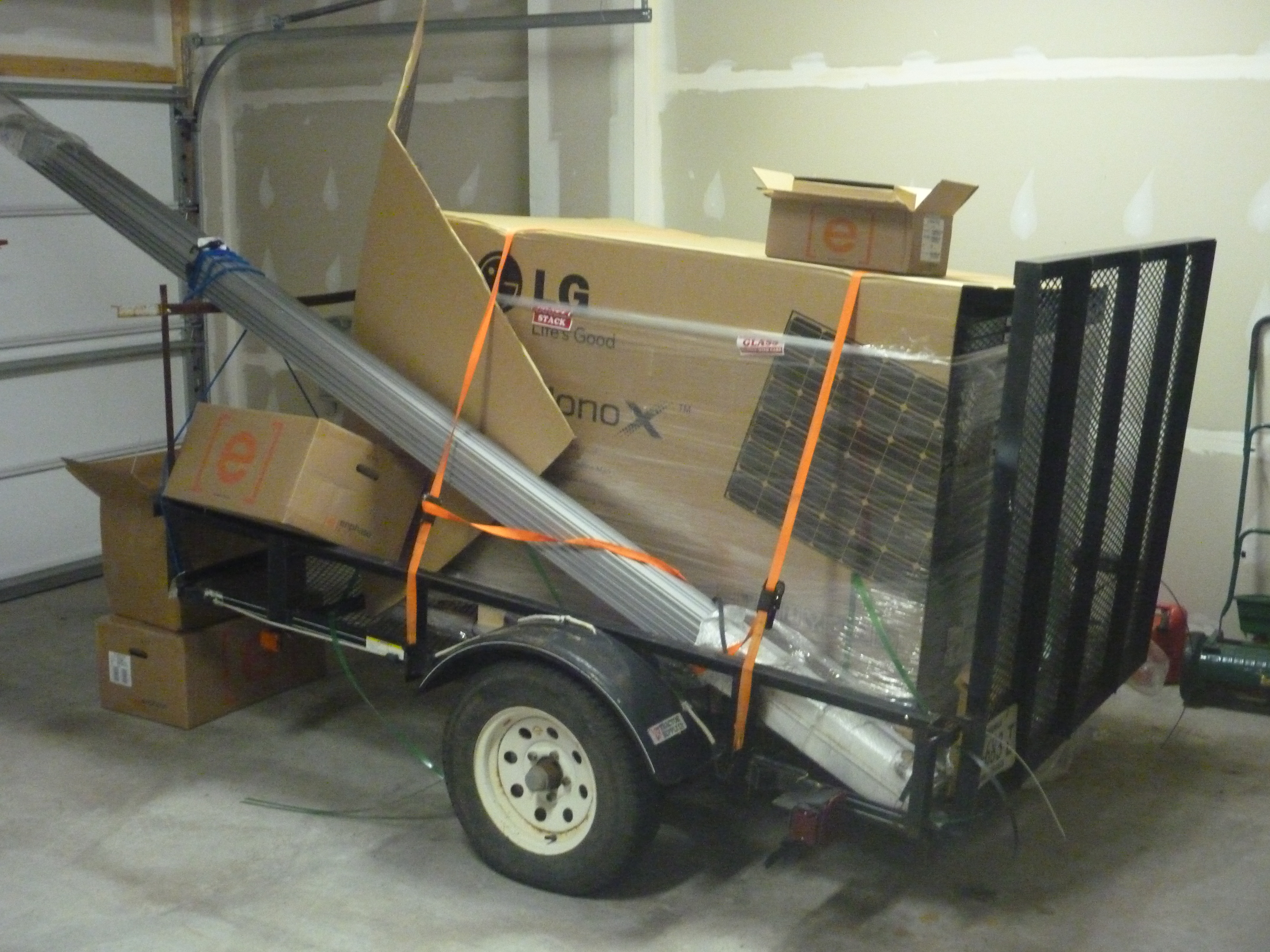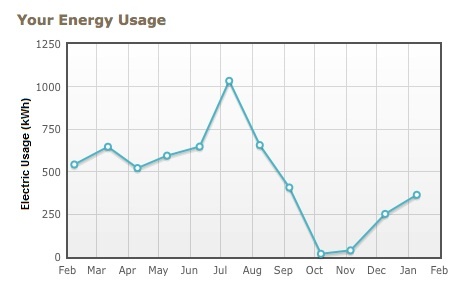Running on Sunshine
You can learn everything about installing solar PV panels from other sources. And you definitely should do that. I just thought I’d write about my experience all in one place. Maybe something here will answer a question you have or inspire you to look into the possibility yourself.
Background
I have wanted to install solar for several years ever since I started learning about the effects of climate change around 2006 or 2007. It just made sense to me and I wanted to make a difference. But I put it off. The prices were always coming down but it was still too expensive up front for me. Also I was living in a smaller townhouse and I knew I wouldn’t be there forever. So I put it off. We moved into a single family home in the summer of 2010. One great thing about this house is that it faces almost due south and has no obstructions around the roof. Great for solar. But I still put it off.
Getting Estimates
Just like any home improvement project you should get multiple estimates. I did that as well. But I did it over several years. Fortunately I met several solar installers through local organizations I became involved with. I asked a lot of questions. I had known the installer I chose for a while. The company is a small local business. And the owner took a lot of time answering my many questions over the last couple years. He thinks I now know more about solar than most of his customers. That might be true if I could only remember all the answers.
You should have no trouble finding installers in your area with a quick search online. Like finding any other contractor, do your homework. Don’t necessarily go with the cheapest company. Check references and any complaints with the BBB and other online sites.
Definitely check out One Block Off The Grid. They can hook you up with estimates from a few companies. But they don’t deal with every company out there so check if there are some smaller companies local to you. It’s always good to support local small businesses.
Ask about what equipment each company uses. Some solar panels have higher quality than others. You might want to stick with a better known brand. Most have a 25 year warranty but you don’t want to pick a company they might not be around anymore.
Finally Pulling the Trigger
Took me long enough. Spring of 2013. There were three things that finally got me motivated to finally go ahead with the installation.
First, my utility, Dominion Virginia Power, was implementing a pilot Solar Purchase Program and it sounded really good. They were going to pay for all of the solar electricity produced at a higher rate than the rate at which we would buy electricity. Now we could break even a lot sooner. And we wouldn’t have to worry about producing more electricity than we used because we would be paid for it. But in the end, at the last minute actually, I decided not to participate in the program. After talking to some other people I found there were downsides beside the fact that the utility still didn’t seem to have their act together on this program. The rate they would pay us just wasn’t high enough. I learned many people complained about this when they first introduced the idea. And the money they would pay us would be taxed, probably as regular income. It would have wiped out most of the benefit. I decided to go with regular net metering instead. If something better comes along later, great!
Second was the worry that prices might not stay as low as they were at the time and that the federal incentives may go away. Of course now I know the prices did not go back up. But at the time the signs were pointing to a possible increase. I had already missed an opportunity for a really good deal a couple years before. I didn’t want to make the same mistake again.
Third, when I got the most recent estimate, my installer told me there was a sale until the end of the month that would save me a little more money.
The HOA Fight
My community is relatively new. I think the first residents moved in around 2007 or 2008. And it’s small, about 200 homes. The community standards guide didn’t mention solar at all. So I put in an application. I expected to get an approval fairly quickly like my other change applications. But since my house faces south, the panels would be on the front of my house. The board took a long time to make a decision delaying the installation by a few weeks. They were checking with their lawyers about whether they could say no or if they could ask me to move the panels. They had a lot of other more minor questions like “Could the panels be painted?”.

My installer and I were under the impression that the HOA could not prohibit me from installing solar panels because of Virginia code about covenants regarding solar power. I thought their lawyer was just interpreting the code differently than us since it is somewhat vague using text like “reasonable restrictions” without explaining what that means. But they finally explained that it didn’t matter because the community rules were in place before 2008:
C. This section shall not apply with respect to any provision of a restrictive covenant that restricts the installation or use of any solar collection device if such provision became effective prior to July 1, 2008.
I didn’t realize at the time how old the community was.
They finally gave me approval during a special board meeting. But after that they added a solar section to the community standards. The section states that the panels must be placed on the side or rear of the house. That will keep about 40% of the homes from adding solar unless they give them an exception. So far nobody else has applied for an installation. Hopefully if we ever decide to move, they won’t make me remove the panels since I am now not in compliance with the guidelines.
Installation
Installation started a couple days after the HOA approval. The day after they started we were off on vacation to the beach for a week. The installation continued while we were away but was slow-going because of the heat and storms. They kept me up to date with text messages and pictures. The roof temperature was 160 to 170 degrees at times. That’s one job I’m not envious of but I’m thankful there are people who do it.
The panels were all installed that week while we were on vacation. Then we had to wait for the electrician to have an opening so he could hook everything up. That was also delayed a little because I was still trying to decide whether to participate in the Solar Purchase Program. That decision would dictate what kind of meters I would need and how the wiring would be done. A couple weeks after the panels were up they finally started producing electricity after all the work was done.
Each panel has a micro inverter underneath it that converts the electricity from DC to AC for the house. The inverters also transmit how much is being produced to the Enphase communications gateway that plugs into the network inside the house. That data is sent to the Enphase servers so you and your installation company can monitor everything online. They will know if there is a problem with any panels.
It took a little while to find a good place for the gateway in the house. It gets the signal from the inverters through the electrical wires of the house. The signal on our wires was unusually noisy so it couldn’t read the data from the location I started with. I had to move it to an outlet in the basement much closer to the circuit breaker.
Inspections
My installer told me the inspections are usually no big deal since the inspectors don’t know that much about solar here in Virginia. But the inspector found a few little things he thought needed to be fixed. Nothing related to safety. And there was some conflict between the inspector and the installer and the electrician about why that work needed to be done. Apparently they had just started being more strict with several solar installations. It took a while to get all of the work done. It was a little inconvenient when they had to get into the house but most work was outside. I didn’t mind too much since the system was still producing electricity and paying for itself.
Operation
For a while almost everyday I would go out and check the electric meter. Before they installed my digital net meter I would just look to see if it was spinning backwards. After I got my net meter I would check if the net amount had gone up or down since the previous day. That went on until it started getting too cold out or too dark when I got home. I still check how much energy the panels have produced on the Enphase website. That is the company that makes the most popular micro inverters for solar panels. The site is pretty nice. You can see which days were cloudy or clear. Here’s one view of my system this past week.
My usage of electricity from the grid has gone down. Here’s the graph from my utility web page. The system went live in July. You can see usage go way down. It has gone up some since because the weather has not been great and I also have an electric car now which needs to be charged. More on that another time.
SRECs Can Save You More Money
An SREC, or Solar Renewable Energy Certificate, represents each 1000 kilowatt-hours of electricity your system generates. It can be sold in various markets around the country. Depending on what state you are in, you may or may not be able to sell your SRECs. Each market has different prices for the certificates. Here in Virginia, I can participate in the Pennsylvania SREC market. But the prices are very low compared to others.
Whether you or I should sell SRECs or whether the markets should exist is a controversial philosophical argument too big for this post. Maybe I’ll cover it in another post.
In the end, if you can sell them, it will help pay for your system a little faster.
Does It make Sense Where You Live and For You?
There are many smaller factors that will go into answering this question.
Do you own a house with a roof? Obviously, if you have an apartment or rent a house, going solar might be a little more difficult. What direction does your roof face?
How long will it take you to break even? It should take me about 10 years. This will depend on how expensive electricity is in your state. It’s fairly cheap here in Virginia which is why solar hasn’t caught on as fast as in California. But solar has come down in price enough that it made sense for us. Also check if there are any incentives in your state in addition to the 30% federal renewable energy tax rebate.
The installers can help answer all of these questions.
Look for other incentives in your local area and state. Search DSIRE to find out.
If you don’t have the money to pay for the installation up front, many companies offer a lease option. The solar company would own the panels. You would pay nothing up front for installation but you’d pay a monthly fee that would be less than your current utility bill. There are several companies doing this now but they aren’t available in every state. Here’s a few:
There are also other types of financing available in some states.
Get Solar Without Installing It
If you don’t have your own roof or land where you can install solar there may be other options for you if you want to make your electricity use greener or if you just want to invest. Community solar power is popping up in some areas. In certain places that allow it, participating in or starting a “Solar Garden” might be an option. You don’t have the panels on your roof but you own the panels where they are installed and the electricity generated goes towards your bill. If you just want to invest in solar projects being installed elsewhere and get a return, look at Mosaic. And Solar City has stated they will be doing the same thing.
Learning More
This is an update to my original blog post added on 7/29/16. One good source to learn more about solar is Solar Action Alliance.
Final Thoughts
Choose your installer carefully. Be prepared to be patient. It probably won’t happen overnight. But I think if you get a solar system, you’ll be happy with it. Finally, a piece of advice I’ve seen on many sites. Reduce your electricity use as much as you can before getting solar so you don’t have to buy a bigger system than you need. Change your bulbs, get more efficient appliances if possible, etc.
If you’d like to share your own experience or have questions, send me a message on twitter or an email or post on your own blog and let me know.



